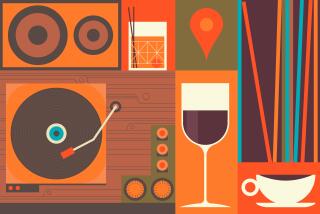Op-Ed: In L.A., thirsting for a decent bar culture
London has pubs. Munich has beer halls. Houston has outdoor honky-tonks. Denver has brewpubs. The drinking scene in Los Angeles is less easy to characterize. Like so much else in this city, it’s diffuse, fragmented and characterized by extremes: There are achingly cool lounges like the Standard downtown, raucous destination bars like Saddle Ranch on the Sunset Strip, and windowless dive bars that often seem anything but inviting.
Taken as a whole, the scene is mediocre, unbecoming of a great metropolis. Los Angeles does not take pride in its bars the way many other cities do. Many neighborhoods revile them entirely.
Homeowners, especially those on the Westside, strain to keep bars out of any neighborhood with even a whiff of domesticity. Take Westwood, for example. Home to 43,000 UCLA students, it has exactly two bar-restaurants and zero true bars. In Pacific Palisades, the No. 1 hit on Yelp for “bars” is a Chinese restaurant; No. 2 is Juice Crafters. The specific plan for San Vicente Boulevard, the main commercial street in Brentwood, outlaws standalone bars. (I sit on the Brentwood Community Council, which is known to have interminable discussions over tastings at wine shops — as if anyone would become a public nuisance after a few sips from an $80 bottle.)
Many Los Angeles residents have no place within walking distance to share a pitcher of beer or a bottle of wine with friends. As a result, they can’t just “get a drink.” They have to “go out,” which often means driving to an area where large numbers of true bars are tolerated, like Downtown, Koreatown, Hollywood or Venice.
The situation may be about to get worse.
In late March, council member Mike Bonin introduced a motion that, if passed, would, according to the Los Angeles Area Chamber of Commerce, add $2,484 to the already astronomical cost of opening a bar or liquor-serving restaurant in Los Angeles. (A bar license alone is $13,800.)
Bonin’s proposed fee would pay for enforcement of development agreements. Bars and “bona fide eating places” (that is, restaurants that are supposed to serve booze only incidentally) operate under conditional use permits, called CUBs. CUBs often are based on rules imposed by neighbors, usually homeowners with political clout. Restrictions can include crowd-control measures, limitations on operating hours and agreements to serve a certain ratio of food to alcohol.
Restaurants break these rules because, in short, demand for night life far exceeds supply. A restaurant that rolls away the tables and turns into a de facto club at 10 p.m. stands to make a killing on alcohol sales. Bonin wants to hold restaurants to their agreements — which is fine, as far as it goes. But doing so ignores the outdated policies and provincial attitudes that lead to these neighborhood efforts in the first place and that restrain our bar culture.
However louche Los Angeles’ image may be, it remains a puritanical city in a puritanical state. California caps the number of bar licenses (not to be confused with restaurants that serve alcohol) at one for every 2,000 residents. That number hasn’t changed since 1939, six years after the repeal of Prohibition.
According to a recent survey of “bar density,” California ranks 35th in the nation, at around 12,000 residents per bar. The national median is 7,000. Who’s drier than California? The Bible Belt. And Utah.
Although alcohol permitting is a state matter, cities issue the CUBs, meaning that they control exactly where bars can locate. Want a demure wine bar on your corner? The approvals process in Los Angeles is so convoluted, often involving consultants, license lotteries, stakeholder outreach, inspections and more, that it can take a year and more than $100,000. And that’s only if your neighbors are on board; which of course requires them to grasp that there’s a difference between a wine bar and a packed, rowdy club for twentysomethings reliving their fraternity days.
Obviously drinking is associated with its share of social ills. But like it or not, drinking is part of the culture of every city this side of Saudi Arabia. And it can bring people together. A whole universe of collaborations and relationships — business, creative, romantic — can be forged over a drink or two.
The city’s urban planners are working feverishly to create more walkable, intimate neighborhoods. Those neighborhoods need destinations worth walking to, and they can’t always be Starbucks. The answer is not fewer bars, but more of them; not tighter, costlier regulations, but looser ones; not suspicious neighbors, but friendlier ones.
Josh Stephens is contributing editor to the California Planning & Development Report.
Follow the Opinion section on Twitter @latimesopinion and Facebook
More to Read
Sign up for Essential California
The most important California stories and recommendations in your inbox every morning.
You may occasionally receive promotional content from the Los Angeles Times.










